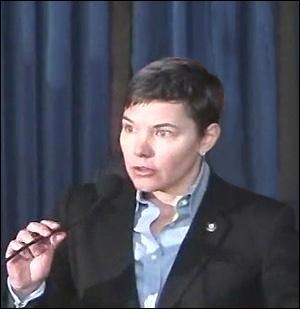Courtesy of Pam Martens.

Jennifer Shasky Calvery, Director of FinCEN, Speaking at a Press Conference to Announce Federal Charges Against JPMorgan for its Role in the Madoff Ponzi Scheme
According to a Freedom of Information Act response received by Wall Street On Parade, Federal law enforcement may share the blame with JPMorgan Chase for allowing Bernard Madoff’s Ponzi scheme to be perpetuated for so long.
On January 7 of this year in a press conference called to announce felony charges against JPMorgan Chase for its role in the Madoff Ponzi scheme, U.S. Attorney Preet Bharara, FBI Assistant Director-in-Charge George Venizelos, and the Director of the Financial Crimes Enforcement Network, Jennifer Shasky Calvery, took turns at the podium excoriating JPMorgan for observing brazen, long-term money laundering activity occurring under its nose in the business bank account it held for Bernard Madoff while ignoring its legally mandated duty to file a Suspicious Activity Report (SAR) with the federal government.
The Financial Crimes Enforcement Network, known throughout Wall Street and the banking world as FinCEN, is a bureau of the U.S. Treasury Department that receives the SARs and is tasked with making sure the reports are seriously investigated.
JPMorgan Chase and its predecessor banks, Chase Manhattan and Chemical, oversaw Madoff’s primary business account for more than 20 years. During that time, flagrant money laundering signs should have set off automated bells, whistles and sirens inside the banks and triggered repeated SARs to FinCEN. None were filed by JPMorgan or its predecessor banks according to U.S. law enforcement until after Madoff turned himself in.
The brazenness of the activity was captured in a 2011 court complaint filed against JPMorgan by Irving Picard, the trustee of the Madoff victims’ fund. Picard told the court that “during 2002, Madoff initiated outgoing transactions to [Norman F.] Levy in the precise amount of $986,301 hundreds of times — 318 separate times, to be exact. These highly unusual transactions often occurred multiple times on a single day. As another example, from December 2001 to March 2003, the total monthly dollar amounts coming into the 703 Account from Levy were almost always equal to the total monthly dollar amounts going out of the 703 Account to Levy. There was no clear economic purpose for such repetitive transactions that had no net impact on Levy’s account at BLMIS [Bernard L. Madoff Investment Securities]. There was a huge spike in activity between Levy and the 703 Account in December 2001. In that month alone, Madoff engaged in approximately $6.8 billion worth of transactions with Levy…” (The term “703 Account” refers to Madoff’s primary business account at JPMorgan Chase which ended in the numbers “703.”)
…



